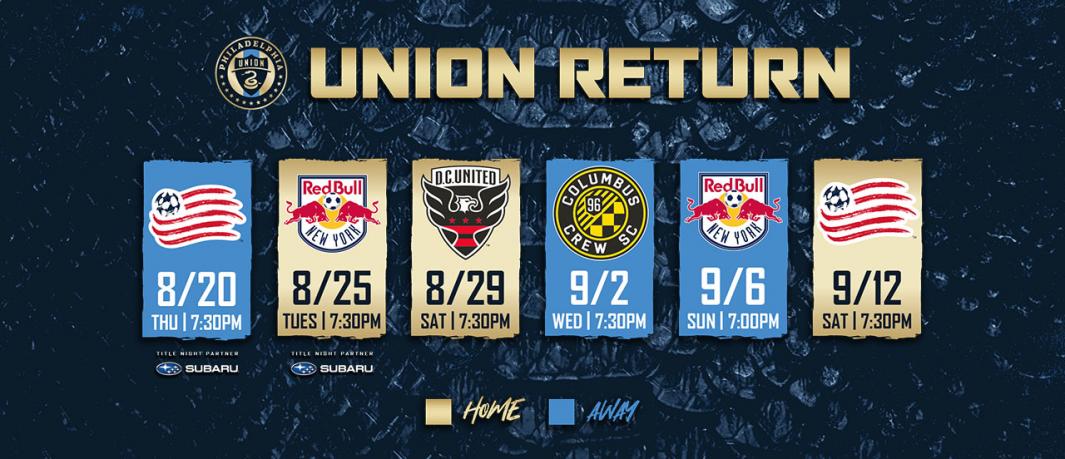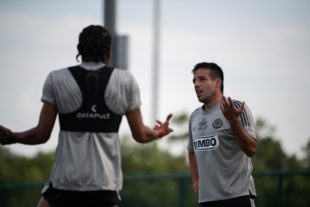Photo courtesy Andrew Zwarych / Philadelphia Union
Well, the bubble worked.
Major League Soccer, minus FC Dallas and Nashville SC, made it through an entire group stage and tournament in Orlando, FL with more than a month of unblemished viral safety.
MLS announces no confirmed positive Covid-19 tests in its final round of bubble testing this evening. They went without a positive for the final 32 days of the tournament.
— Mike Conti (@MikeConti929) August 11, 2020
But like the fish who finally escaped the dentist’s office at the end of the famous children’s movie Finding Nemo, the question is: now what?
Now what?
At the beginning of July, Philly Soccer Page posted an article about the MLS is Back Tournament, entitled “Darned if you do, darned if you don’t.” If the reader missed that day’s content (shame on you), the gist was this: there was no good way to move forward with soccer in America given the state of the virus in America, and that the bubble option was the least worst one.
The league made that least worst option into a fun and entertaining spectacle, culminating in a great final between Orlando City SC and the Portland Timbers.
The day after that final saw the aforementioned Dallas and Nashville kick off the first phase of the league’s non-tournament regular season, no rest for the weary and such. By now fans know that this season will happen in phases, with regional matches setting the stage for whatever is possible in a month’s time.
At this time, MLS has announced the initial phase of the revised schedule through September 16 and plans to announce the balance of the regular season schedule by early September. Attendance at matches will be determined by MLS and club leadership in accordance with applicable state and local guidelines.
The Union have six matches scheduled between Thursday and September 12th, all against conference sides that can be reached and returned from in a single day. PSP’s own Peter Andrews covered the announcement when it was made, and as of publication it appears fans will not allowed at any of the six competitions.

Courtesy of Philadelphia Union
Lessons learned
This restart certainly isn’t happening in a vacuum, with sports worldwide inching their way toward normalcy and even the most vigilant countries dealing with “outbreaks” in various form and size. Because of the aforementioned bubble and the time it afforded the league, MLS gets the benefit of restarting their in-market matches after learning some lessons from other high profile American sports.
- Major League Baseball: Baseball has been moving forward in fits and starts. The Philadelphia Phillies for example were idle for a week just days after the start of the season when the Miami Marlins failed the league’s basic protocols and put both team’s season at risk. Since then, there have been several one-off cases on various teams but it appears like the league will get their full/abbreviated season done.
- LESSON: The lesson here is that teams can’t be allowed to dictate their own safety, a third-party is required and his or her decision must be the most valued.
- The NBA: Like MLS and the National Women’s Soccer League before them, the NBA is fully “bubbled” and having success as a result. A clean month of tests allowed the league to finish its regular season with the playoffs starting soon.
- LESSON: The bubble is the best (Author’s note: …and the most fun Nintendo game ever made might be “Bubble Bobble“).
- College Football: The Big Ten and Pac-12 cancelled their seasons last week, while the ACC, SEC, and Big 12 continue to soldier on for now. The respective medical professionals in each league are working with the same information but coming to different conclusions. That alone is hard to process, and given the nature of their “labor” forces, these decisions come with significantly more unique variables.
- LESSON: Labor issues are paramount to this decision, and long-term goodwill or long-term distrust will likely be solidified in this moment.
- USL: The Union’s developmental side had a match postponed last week because of a positive test, while the league overall has largely avoided major issues by limiting stadium capacity and mandating masks inside the park.
- LESSON: Sports can be safely played in a pandemic as long as sports fans take the responsibility of keeping themselves and their section-mates safe.
How to measure success
Perhaps the most important metric in this restart is how fans, teams, players, the league, and frankly the media measure success. Without the bubble, a world in which the league keeps a perfect record against the virus is over.
There will be a positive test.
In fact, if testing gets better and faster (as seems to be happening, thankfully), there will likely be positive tests on a regular basis (recent formulations on testing and population infections rates surmise that the data underestimates the breadth of this virus by a large amount). This is a sign of good protocol and league safety, in the same way that a player being held out with a tweaked ankle is better for his or her long-term health than playing through the pain and risking larger injury. Obviously the virus presents a different dimension of this problem, but more data is always better than less when trying to pull off something of this scale and an asymptomatic player with a positive test who is held out before he can infect his teammates is an enormous victory for the league.
So, measuring success based on zero positive tests can’t be the bar anymore.
For players and fans, success is being smart with distancing and masks, and honest about staying home when they’re not feeling well.
For the league, success is a fair, honest, and predictable protocol that puts the overall success of the league ahead of any player or team’s desire to play.
For observers and the media, success is making sure to hold all groups accountable to their responsibilities.


The success of the MLS bubble shows the need for isolation for the rest of the country (i.e. you and me) to try and quash this thing.
.
Another sport to take a look at is NASCAR. They picked up in mid-May and have not used a bubble. Most of the races have no fans while a few have some widely spread apart from each other. So far, two drivers have tested positive. One probably caught it from his wife, I haven’t heard about the other since it was just this past weekend. Both drivers are required to have 2 negative tests at least 24 hours apart before they are allowed to resume racing.
.
I have not heard of any crew members testing positive. I believe they are checking everyone’s temperature before they enter the track. They have eliminated practice and qualifying to limit time at the track. Almost all interviews have been done using masks (except when the drivers are just getting out of the cars and catching their breath) and mics on a pole held out in front of the drivers face to allow social distancing.
.
Their is usually one pit reporter at the race while all of the other commentators are back in the studios in Charlotte. So far, I thinks it’s worked pretty well, although I know it will be more difficult for soccer players to go into a game without practicing between games.